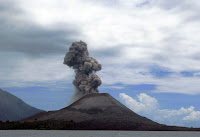Koes Plus
Koes Plus is an Indonesian musical group that enjoyed success in the 1970s. Known as one of Indonesia's classic musical acts, the band peaked in popularity in the days far before the advent of private television companies, delivering stripped-down pop songs at the then-only TV station, TVRI.
Hailing from the Bojonegoro-Tuban area in East Java, the band started out as Koes Brothers (Koes Bersaudara), consisting entirely of the Koeswoyo siblings. Its antics of pioneering Beatles-influenced rock 'n' roll subculture in Indonesia was proven to be controversial, as the brothers were subsequently arrested by the Highest Operation Commando (KOTI) in 1965. They were eventually released just the day preceding the nation's coup d'état, in September 29. This experience resulted in their song Di Dalam Bui.
When drummer Nomo quit in 1969, Murry was then invited to fill the niche, but the decision caused an internal uproar as the band was initially projected as a family act. The feud was then resolved by rebaptizing the band as Koes Plus. It consisted of the Koeswoyos plus an outsider hence the name.
Koes Plus' early days were rugged, as record companies insisted on rejecting them. Murray became frustrated at some point and temporarily quit the band, distributing their records freely as well as joining several other acts. Not until their songs were played on the state radio network did they gain considerable fame.
Koes Plus, infamously, never owned any legal rights pertaining to their works- they were paid only by the time they produced an album. Consequently, the band never enjoyed any form of royalties whenever their works are being reproduced. In recent years, the band members have apparently been having financial problems despite the fact that their musical legacy has obviously left its mark on the local music scene.
The band still performs live, the enthusiastic spirit of these legendary songwriters and musicians belying their age. Oldies but goldies such as CintaMu Telah Berlalu, Mobil Tua, Angin Laut, Diana, Maria, and Kapan-Kapan have lost nothing of their freshness and appeal; the audience, currently consisting of three generations of Koes Plus fans, tends to know all the lyrics by heart. Their only English song, Why Do You Love Me? also received a lot of airplay in Australia.









